One of my father’s 1980s photos was of the war memorial in Cyprus Street, Bethnal Green:
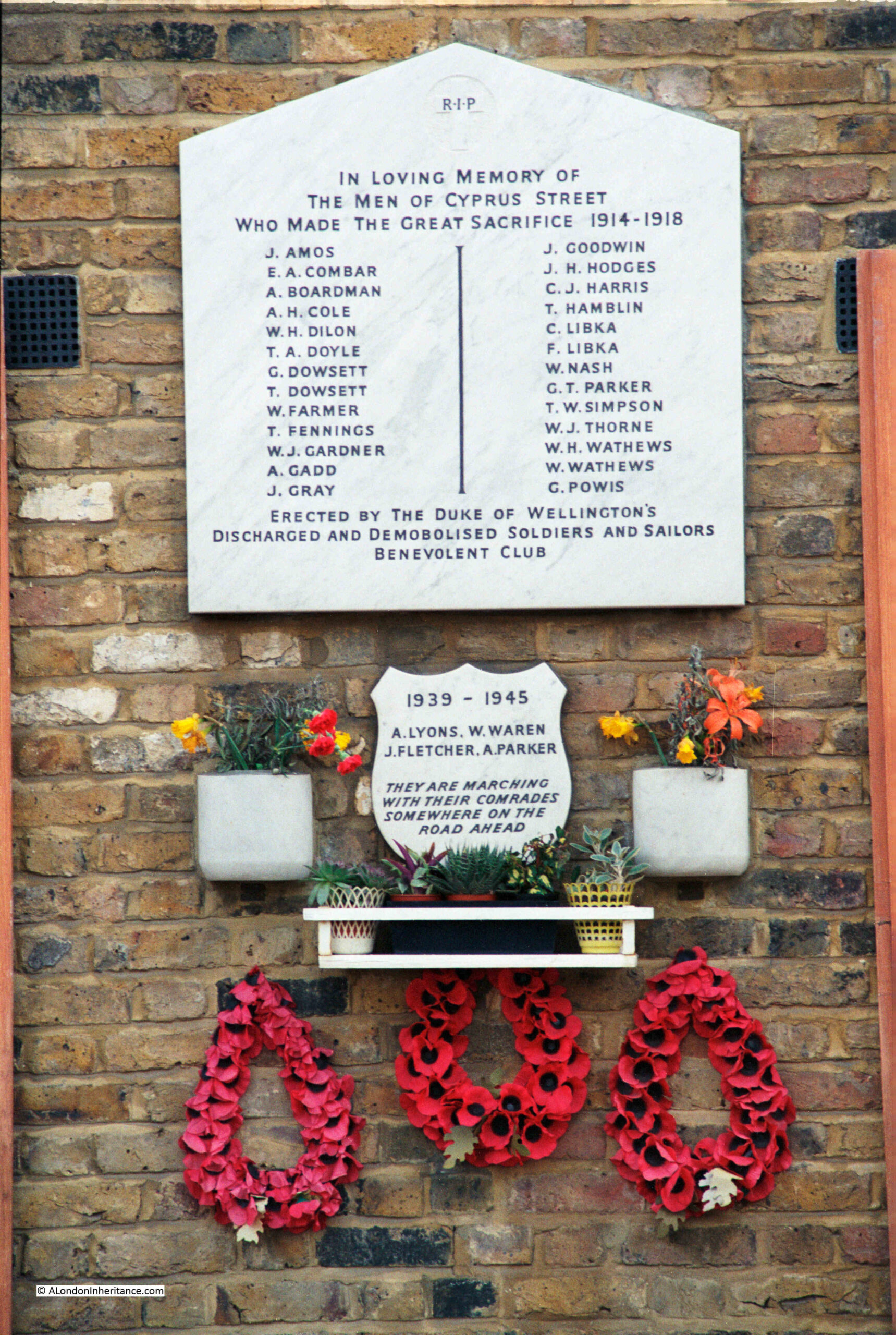
Forty years later, I went back to take a 2023 photograph:
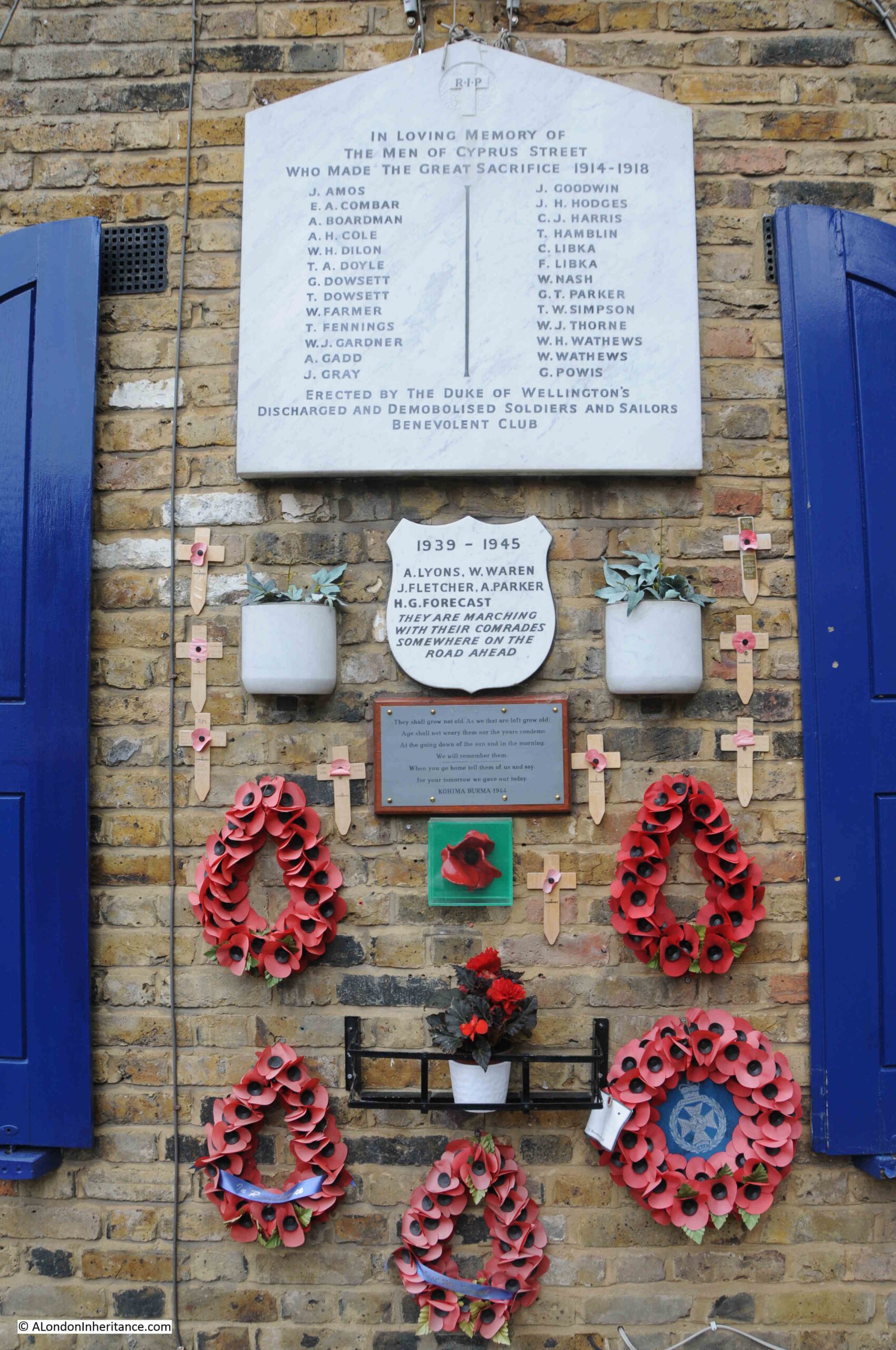
There are a couple of interesting changes to the overall memorial. The small memorial below the main First World War memorial is for the Second World War, presumably also for those from the street who died during that war. In my 2023 photo, this plaque has had a name added since the 1980s.
Below that there is a new plaque which has been added:

And below the above plaque is one of the ceramic poppies from the 2014 display in the moat of the Tower of London to commemorate the start of the First World War.
The memorial in Cyprus Street:
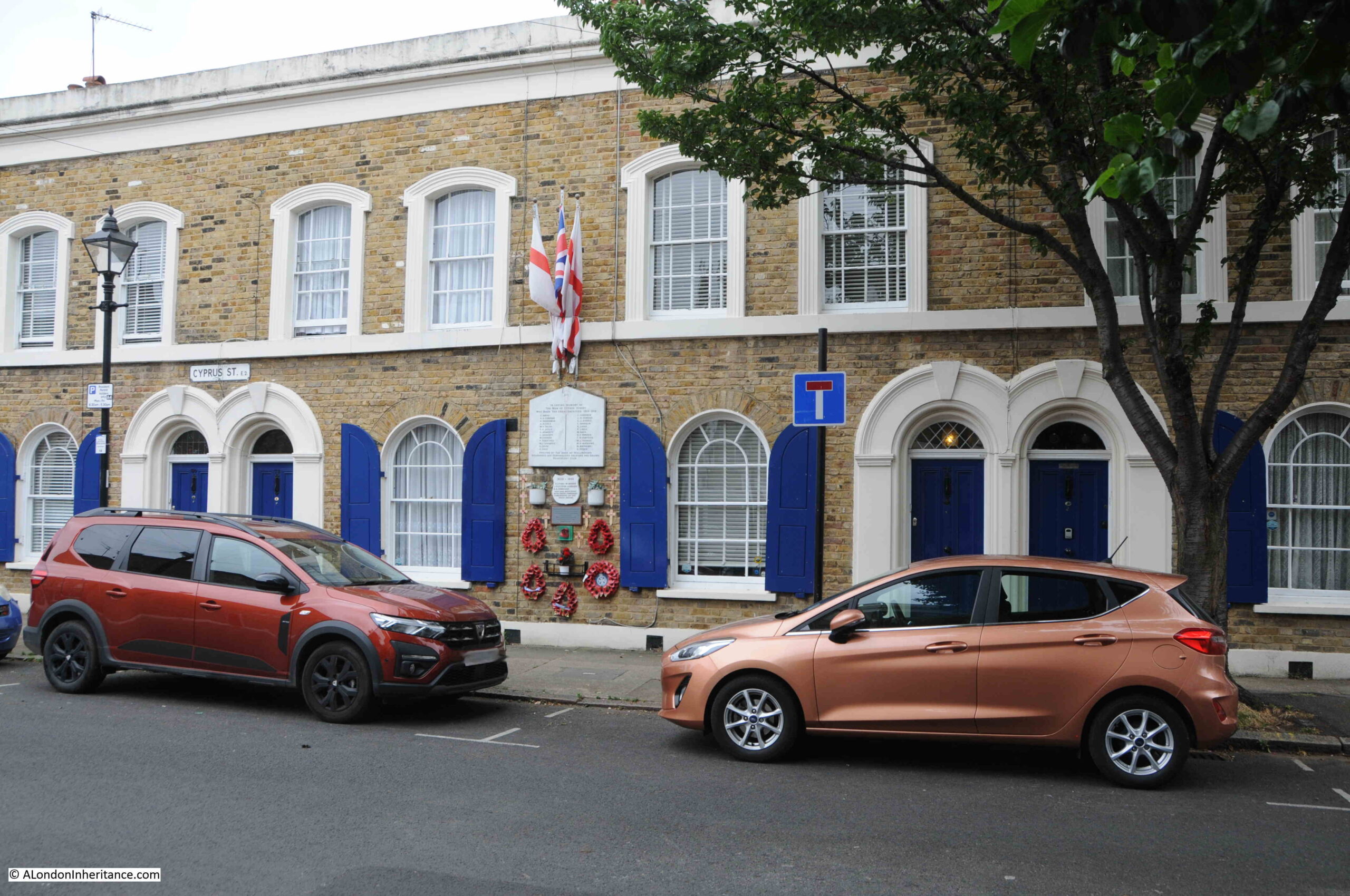
The memorial is not in its original location. I have read a number of slightly different stories online about the fate of the original memorial, and move to the current location. I will use the following quote from the publication “Not forgotten, A review of London’s War Memorials”, published by the Planning and Housing Committee of the London Assembly in 2009:
“The memorial was originally on the wall between numbers 45 and 47
but in the 1960s, when one end of the street was redeveloped for a
new housing estate, the main memorial was broken while it was being
removed. The community rescued the plaques and for a while the
fragments lay around the local pub, the Duke of Wellington. After a
number of years the community took the opportunity to use the
refurbishment of their street to make a collection to pay for a replica
of the original memorial to be made at a local stonemasons and got
permission from the housing association to relocate it to where it now
stands.”
The London Assembly document states that the current memorial is a replica of the original. I have read other accounts that state it was repaired, however if that is true, then it must have been a very good repair.
The problem with determining which sources are correct is difficult as even in the London Assembly document there is an error. It states that “The original Cyprus Street memorial was erected at the end of 1918 to commemorate the residents of the street who died in the First World War”, however I have found a number of reports from newspapers of the time which state that the memorial was unveiled in 1920, perhaps there was a two year delay between erecting the memorial and unveiling, however I doubt it.
It is always difficult to be 100% confident in many statements that are recorded as facts.
What ever the truth of the memorial, nothing can detract from what it represents – the impact of war on one small London street.
The plaque was unveiled on Saturday the 5th of June, 1920, and the East London Observer had a report of the unveiling in the following Saturday’s issue:
“A BETHNAL GREEN WAR MEMORIAL – In Memory of Cyprus Street Men. A touching ceremony took place last Saturday afternoon at Cyprus Street, Bethnal Green, where there was unveiled and dedicated a War Memorial Tablet to the men of the street, which is in the parish of St. James-the-Less, Bethnal Green, who had fallen in the Great War. The memorial was raised by the members of the Duke of Wellington’s Discharged and Demobilised Solders’ Benefits Club, of which Mr. Keymer is the Chairman.
The St. James Brass Band opened the service and after hymns, prayers and lessons, the Rev. J.P.R. Rees-Jones, Vicar of the parish, unveiled and dedicated the memorial tablet.
The tablet is of white marble with imperishable lead lettering, with a beautiful scroll, the work being executed by Messrs. B. Levy and Sons, ltd. monumental masons, Brady Street, Whitechapel, a firm which has gained much notoriety by virtue of the excellence of workmanship and design, and the tablet was greatly admired by all who attended the interesting ceremony.
The Vicar gave a short but inspiring address, and after an anthem, “What are these arrayed in white robes”, given by the St. James’s choir, and the hymn “Lead Kindly Light”, the blessing was pronounced, followed by the “Last Post”, the “Dead March” and “Reveille”. There was a large assembly, and for once in a way Bethnal Greeners stopped to think of something else than their every day cares.”
The names on the memorial joined the names on thousands of other war memorial that were erected after the First World War, and the problem with war memorial is that the sheer number of names hides that fact that these were all individuals, and I have tried to find out about some of those listed.
In the 1911 census (the nearest I can get to the First World War for a full list of those living in Cyprus Street), there were 827 people recorded as living in the street.
Given that 26 people are listed as having died during the First World War, assuming roughly the same number of people were living in the street as in 1911, then 3% of the street’s residents would die in the war.
Whilst this may initially seem a relatively low number, many families at the time would have large numbers of children, so as a percentage of adults in the street, it was much higher than 3%.
When comparing the names on the memorial, I was surprised that a relatively high number were not listed in the 1911 census, implying that they were not then living in the street, I did wonder if those commemorated were from surrounding streets, however the memorial clearly states that they are the men of Cyprus Street.
I did find a number listed in 1911, and the census records provide a more rounded view of the names on the monument, for example:
- A. Gadd – The Gadd family lived at number 51 Cyprus Street. There were two Alfred Gadd’s in the family. The father who was 45 in 1911 and the eldest son who was 18. The father was a Cabinet Maker, and the son was Linen Collar Sorter. I suspect that it was the son who died in the war, as the father would have been approaching 50 by 1914. As well as the father and oldest son, there was the wife Elizabeth (44), daughters Rosalie (20, a Brush Hair Sorter) and Elizabeth (16, a Dressmaker)
- J. Goodwin – The Goodwin family lived at number 91 Cyprus Street. There were two John Goodwin’s in the family, however the eldest son John was only 6 in 1911, so it is the father, who was aged 27 and listed as a Butcher who died in the war. As well as the father and oldest son, there was the wife Elisa (26) and children Robert (5), Charles (4), daughter Grace (2) and youngest son Sidney (0, born in 1911)
- T. Hamblin – The Hamblin family lived at number 59 Cyprus Street. T. Hamblin refers to Thomas Hamblin who was 32 in 1911 and listed as a Dock Labourer. He lived in the house with his wife Elizabeth (30 and a Tailoress). No children are recorded.
- W. J. Gardner – There was no W. J. listed in the 1911 census, but there was a William Gardner at number 64, so I assume he may have left his middle name out of the census. William Gardner was 27 and a Builders Labourer. He lived in number 64 with his wife Florence (25 and a Skirt Machinist) and daughter Florence who was 4.
Just four out of the twenty-six who are listed on the memorial, but it reminds us that these were individuals with jobs and families, who would have impacted by their loss for very many years to come. The youngest child, Sydney Goodwin would hardly have known his father and Sydney could have lived to the end of the twentieth century.
It is also interesting to compare the number of names on the memorials for the First and the Second World Wars, with far less from the street who died in the Second World War.
This comparison shows the absolutely appalling death rates from the trench warfare of the First World War.
The reference on the memorial to the Duke of Wellington’s Discharged And Demobilised Soldiers And Sailors Benevolent Club refers to the Duke of Wellington pub in Cyprus Street. The pub was built around 1850 as part of the development of Cyprus Street and surrounding streets. The pub closed in 2005, but today still very clearly retains the features of a pub, including a pub sign:
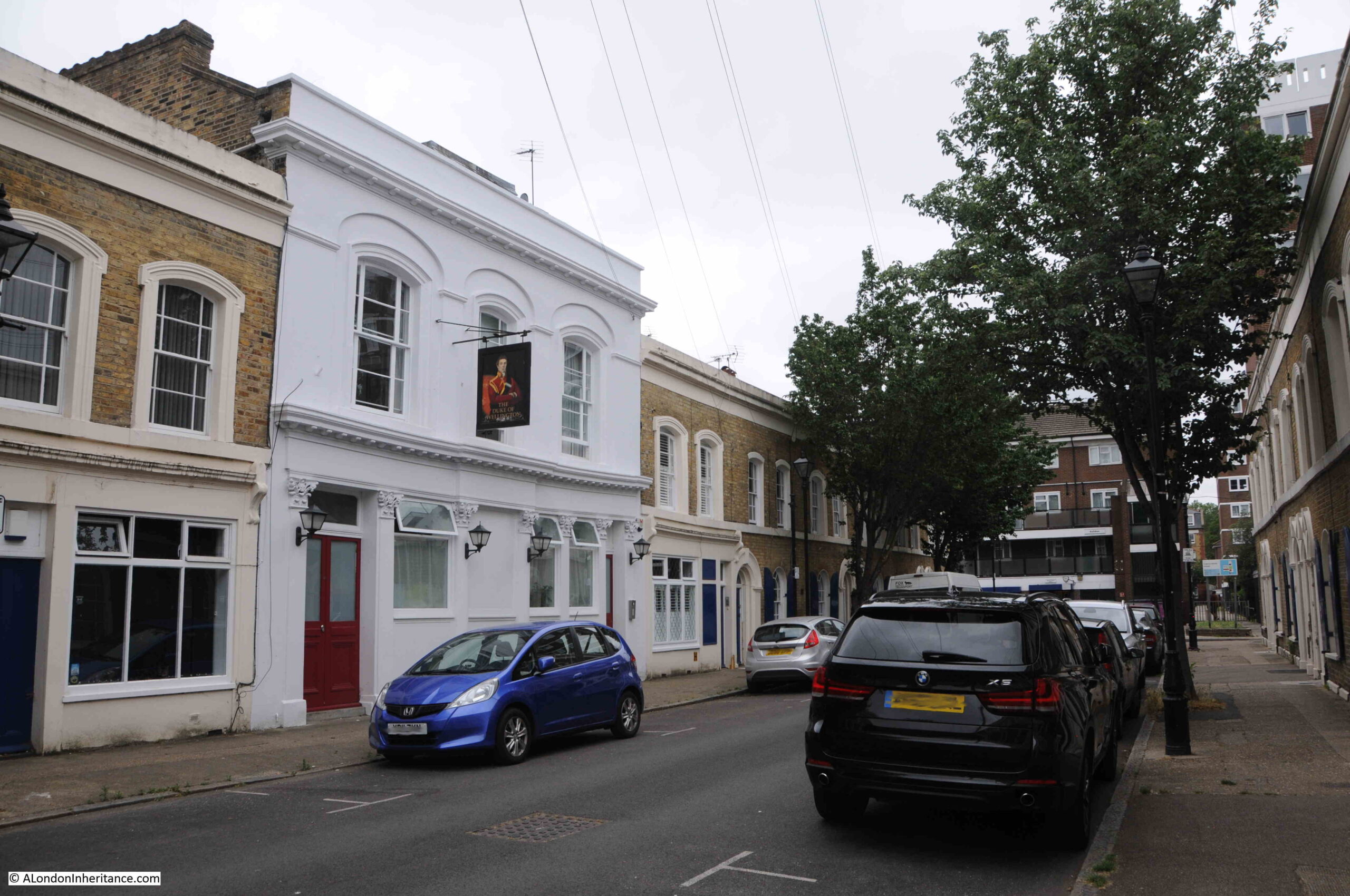
The Duke of Wellington, like many other pubs in the working class areas of London, had a tradition of hosting benefit and loan societies.
In 1911 there was a large advert for the Duke of Wellington in the Eastern Argus and Borough of Hackney Times headed “Important Notice”. It was one of the very many adverts that publicans would place in the local newspapers when they took over a pub. The advert would tell potential customers that all classes would receive a warm welcome, that only the very best beers and spirits would be served, and the advert of the Duke of Wellington also included that:
“The United Brothers Benefit Society meets here every alternate Tuesday evening and the Duke of Wellington Loan and Investment Society (which has been established for over 20 years) every Saturday evening. New members to both societies respectfully invited and heartily welcomed.”
It was hosting societies such as these, as well as the very many clubs and societies involved with sports and games that put these 19th century pubs at the heart of the communities that developed around them.
The pub, as well as much of the original Cyprus Street terrace houses are Grade II listed.
A chunk of the western part of Cyprus Street was badly damaged during the Second World War and the Cyprus Street Estate was built across the area that was damaged. This has effectively separated two parts of the original street.
In the following map, the red oval shows where Cyprus Street has been separated by the new estate, with a short stub of the street to the left, and the main section of the street to the right ( © OpenStreetMap contributors ):

The new estate can be seen just to the west of the old pub:

Cyprus Street is fascinating, not just for the war memorial, and architecture of the terraces, but also the way they are decorated, with many of the houses having a brightly painted front door and window shutters:

View along the main surviving section of the street:

Cyprus Street is identical to many other mid 19th century streets that appeared as Bethnal Green was developed, what has made it special is the war memorial and the retention of the majority of the original terrace houses.
As indicated by the Duke of Wellington’s Benevolent Club that erected the memorial, the pub must have played an important part in the community that lived along the street.
There were so many pubs in Bethnal Green (as there was across much of London), and in Bethnal Green the majority have closed, with many being demolished or converted into flats.
As I was walking to Cyprus Street, along Bonner Street, I saw another old pub just after the junction with Cyprus Street.
This is the Bishop Bonner, on the corner of Bonner Street and Royston Street:
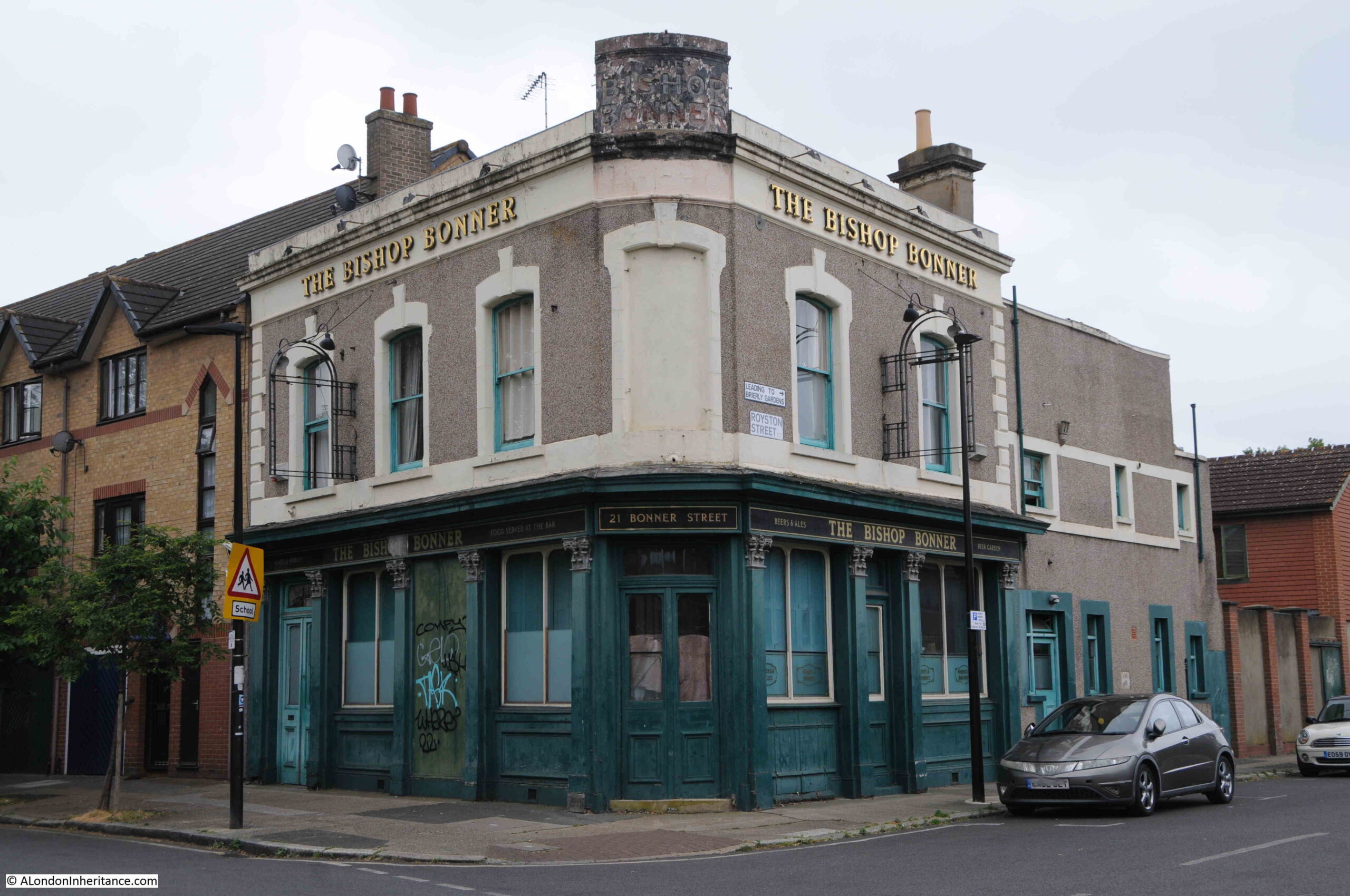
Another 19th century pub, which finally closed in 1997. The first floor appears to be flats, however the ground floor looks rather derelict. It would be interesting to look in and see if any of the remaining bar furniture survives.
Name sign on the corner of the pub:

Always interesting to think of the thousands who have walked through these doors, when the pub was the hub of the local community for well over 100 years:
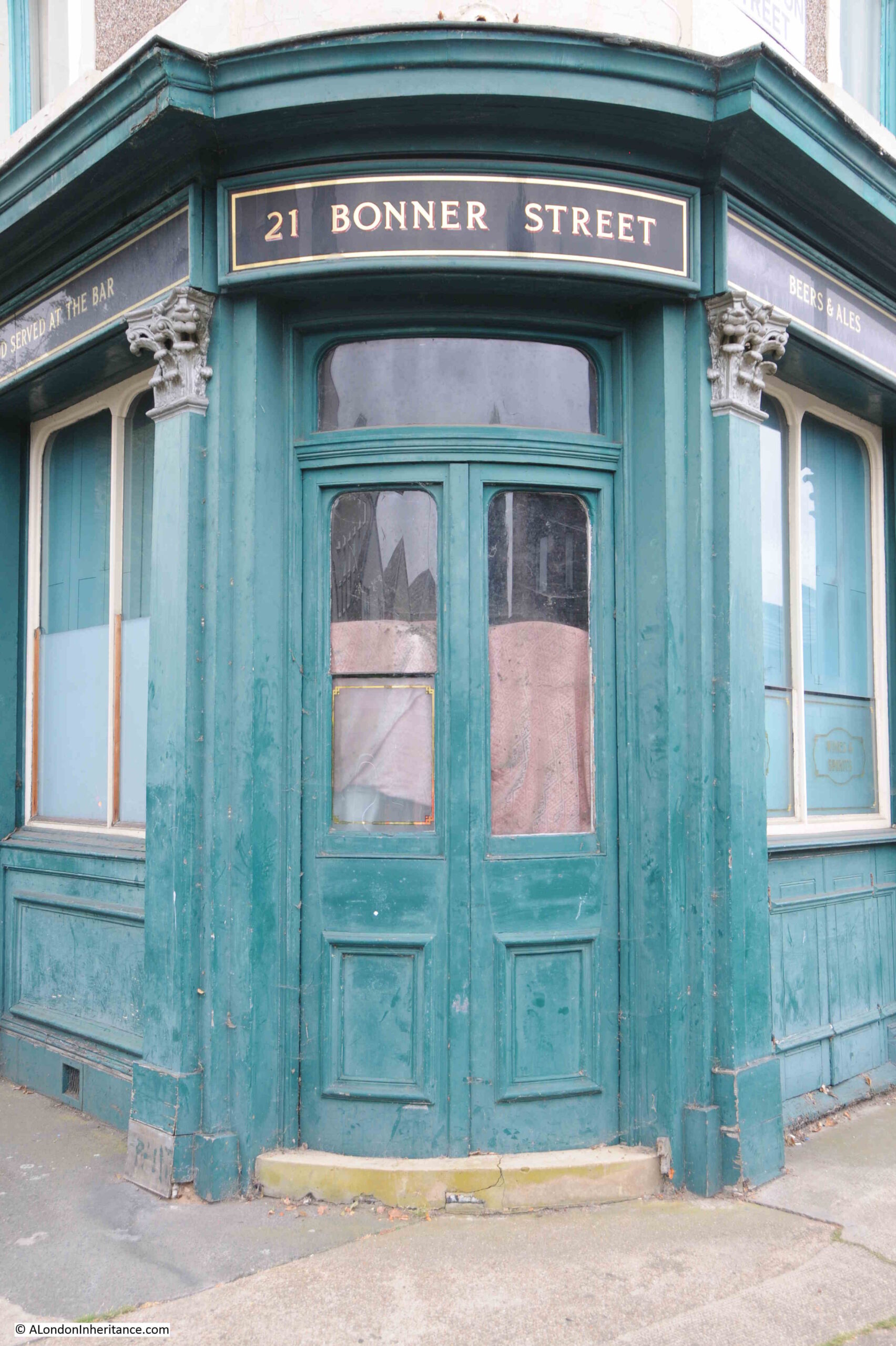
Whilst so many of London’s pubs disappear or are converted, the memorial in Cyprus Street remembers not just the residents of the street who died in the First and Second World Wars, but also remembers the community that was in the street at the time, that enabled the memorial to be created and maintained during the following decades.

I wonder how one gets a list of the men who are mentioned in the war memorials.
The Commonwealth War Graves Commission (CWGC) website is the best place to start for those of the British and Commonwealth Armed Forces and Merchant Navy lost in either of the two World Wars. In addition, the IWM’s War Memorials Register records some from earlier conflicts as well although for highly questionable reasons and despite describing itself as a national register, it no longer includes CWGC memorials.
Echoing the street memorial concept above, during the First World War centenary, Portsmouth put simple laminated signs on lampposts listing the names of those former residents of the street in question lost during the War. Highly commendable, inexpensive but telling yet how many towns and cities did the same?
Islington Council list the fallen men on the street furniture. I find it very touching to read their names, ages and where they died. Interesting to see how the ages of the men increase as the slaughter progressed along with the duration of WW1.
https://www.cwgc.org/find-records/find-war-dead/
Interesting article as I grew up in Bethnal Green in 1960s and remember the memorial. Also I saw a Chas & Dave play in the Bishop Bonnet pub late 70s as a regular pub band!
A very interesting read -such a loss of life in a small community and mirrored elsewhere across the country.
Always interesting!
A lovely reminder of how small, simple legacies of huge events can speak volumes about them. Sad to think that many streets of London and elsewhere could provide testimony of similar suffering. It also particularly saddens me when I see more than one member of the same of the same family listed on memorials.
I very much enjoy getting your posts by email. I am a Londoner, now living in Norfolk.
I was amused by the difference in architecture of the pub, the Bishop Bonner, and Bishop Bonner’s cottages in Dereham, mid-Norfolk. https://www.derehamhistory.com/museum.html . There is a fairly tenuous link to Bonner as he was given the living of the adjacent church, along with other sources of income, but it not known if he visited Norfolk often. However, he did give money in his will to the almshouses by the church, which may or may not be this row of cottages.
Thank you, Admin, that was a very interesting and thought provoking post.
I have a photograph of the memorial in the early 1930s. My mother lived in Cyrprus Steet until she married in 1934 (she was living there in the 1921 census). She lived at #36 – one of the house demolished to make way for the new road. She must have lived almost opposite where the memorial was orginally located.
I visited the street about 6 weeks ago and it is great to see it so wonderfully maintained. It is stange to walk there where my mother and her family walked one hundred years previously.
The replica always upset my Grandfather (now passed), as his fathers name is spelt wrongly, it is Thorn (without the E). And they refused to correct it. His name is correctly spelt on his grave in Englebelmer cemetery (not far from Thiepval)
Thanks again for another interesting post.
An excellent piece, thank you.
One wonders also how many of those from the street survived but were wounded – perhaps the 1921 census, now available, might throw some light on that.
On a separate point, your photos show that the houses are paired, with adjacent doorways. However, that entitled “The new estate can be seen just to the west of the old pub” shows behind the silver car at the front a group of three – what was the purpose of the central “interloper”? Does this occur elsewhere?
The central doorway may be the entry to a shared covered way that leads to the back of the houses on each side.
Another interesting post and curious as to why there is a specific one to Kohima. My uncle survived the battle, starting off as a second lieutenant and ending it as a field Captain, then the youngest in the British Army. Worth reading about as it was the point at which the British Army turned the Japanese, although generally forgotten today.
Fascinating, as always. The spelling mistake on the memorial may indicate that it is a replica – I think it would have been spotted and corrected, if necessary, on the original.
It’s not very surprising that so many of the dead can’t be found in the 1911 census on Cyprus Street. Most people were renters and weren’t tied to one house. With far less possessions than folk have now, they could move quite easily to a property, or part of a property, as their housing needs changed.
One example was my grandfather who just happened to be the licensee of the Bishop Bonner mentioned above. He moved into it in 1924 from the Palmerston on Well Street Hackney (now Well Street Pizza) and moved on again in 1926 to a pub in Homerton. The Bonner Arms had a small entertainment area attached (my dad called it a music hall). It was still going strong in the 1970s and there is archive footage from a TV programme, Word of Mouth with Melvyn Bragg. He is talking to locals about Cockney dialect while Chas and Dave are performing in the pub. The clip can be found on YouTube.
Bishop Bonner was the Bishop of London from 1539 to 1549 and again from 1553 to 1559. He was a particularly zealous priest who persecuted protestant heretics during the reign of Queen Mary. He was known as Bloody Bonner. But Bonner Street is more probably named after the manor house, Bonner’s Hall (named after the bishop originally), which stood until 1845 near to Victoria Park on the site occupied until 2015 by the London Chest Hospital. It is an ancient site with Roman bricks and tiles found in the 19th century and was the site of the original Stepney Manor.
Incidentally there was another pub on Bonner Street called the Bonner Arms – almost opposite the Bishop Bonner.
I used to live on this street. Great article, nice to read about so much of the history of the area. The Camel remains my favourite pub in London, I hope you managed to stop in for a pint
Thank you so much for the blog posts; the quantity and quality of your work never ceases to amaze me!
The vagaries of whose name appears on war memorials … Having checked the Commonwealth War Graves website, Cyprus Street, Bethnal green, is only given as the address for two people, both victims of the Bethnal Green Tube Station disaster. Elizabeth Bendon and her married sister Lilian French lived at number 73 Cyprus Steet which was just over your right shoulder as you took the photo of the war memorial. Their gravestone is shown here:
https://www.findagrave.com/memorial/24610264/elizabeth-matilda-bendon?_gl=1*1fspvy9*_gcl_au*MjAzODY2MDM4Ny4xNjkwNzUxMjk0*_ga*NjMyNjk5ODYyLjE2OTA3NTEyOTQ.*_ga_4QT8FMEX30*ZmJjMTRkNmItNzM3OS00NTY0LWJkZmYtMzlkZmY0OWYxMjg1LjEuMS4xNjkwNzUyMjMwLjI1LjAuMA..
there is also a brief account of what happened on the evening they died.
Of the five people named as victims of the Second World War, none have Cyprus Street as their home address – possibly they grew up living there, still had family in the street but had moved away?
The most distinctive of the Second World War names is W. Waren, because of the unusual spelling of the surname. From CWGC, he was Lance Corporal William Waren (junior) of the 1st Kings Shropshire Light Infantry. Given his battalion and date of death, 31st January 1944, we can very probably place him at Anzio in Italy.
In 1939, he was a market porter (fruit and veg), living at 90 Cyprus Street with his parents and two siblings. In the following summer he married a local girl, Irene Buckley, and they seem to have moved to South Woodham by Chelmsford in Essex (at least that was where his wife was living at the time he was killed). To top this sad story off, he has no grave and is commemorated on the Cassino Memorial with over 3000 other Commonwealth servicemen.
I was born and grew up just around the corner from Cyprus Street and so the memorial has always been very familiar to me. The second name listed – E. A. Combar – originally caught my attention when I was young as it was not listed alphabetically and later I began to wonder whether it should actually have read E. Agombar (Agombar being a very common Bethnal Green surname).
In more recent years I was able to do some research online, mainly through Ancestry, and did indeed discover that Edward Agombar, a Lance Sergeant in the 1st Kings Dragoon Guards who lived at 82 Cyprus Street, was killed in action on 1st June 1915. Although Edward is sadly not commemorated correctly on the Cyprus Street memorial his name does appear on the Menin Gate Memorial in Ypres, Belgium.